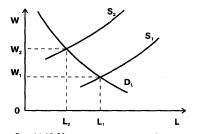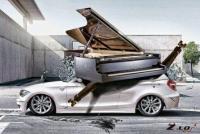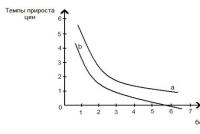What is the main indicator characterizing the assets of the company. Intangible assets. Cost and average value of cumulative assets
Enterprises. It consists of material, financial and lovely assets.
Dictionary of Financial Terms.
Assets of the company
the property of the enterprise, reflected in the balance sheet. Basically, there are three types of assets: 1) current assets consisting of cash capital and funds that can be rapidly transformed into cash; 2) fixed capital with a long service life used by the enterprise in the production of goods and services; 3) Other assets that include intangible assets that do not have a natural-real form, but valuable for the enterprise, investment in other companies, long-term securities, expenditure of future periods and various other assets.
Terminological Dictionary of Banking and Financial Terms. 2011 .
Watch what is "assets of the enterprise" in other dictionaries:
Assets of the company Encyclopedia Rights
Assets of the company - Property of an enterprise consisting of material, financial, non-property assets. The enterprise's material assets include land plots (both owned and in use), buildings and facilities of industrial and ... ...
Assets of the company - (English ASSETS of Enterprise) Property of the enterprise. It consists of material, financial and intangible assets. To the material A.P. include land or the right to use it; Buildings and facilities of industrial purposes; Buildings and ... ... Big Law Dictionary
cash assets of the company - the aggregate amount of funds of the enterprise, which is at its disposal to a certain date and representing its assets in the form of finished payments (i.e., in the form of absolute liquidity). Consist from: 1) funds on the deposit account ...
Cash assets of the company - (Enterprise Cash Assets, Monetary Assets) Cumulative amount of funds of the enterprise at its disposal for a specific date and representing its assets in the form of finished payments (i.e., in the form corresponding to ... ... Economics and Mathematical Dictionary
Financial assets of the company - See the assets of the enterprise ... Encyclopedia Rights
Financial assets of the company - See the assets of the enterprise ... Big Law Dictionary
Clean assets - Net Assets. Pure net Assets of the enterprise are an excess of the value of the company's assets over the external obligations that are reflected in the balance sheet report. Net Assets are one of the forms of expression ... ... Banking Encyclopedia and Finance
ASSETS - a collection of property, property and non-property rights (property) belonging to a physical or legal entity. See also company assets ... Legal Dictionary of Modern Civil Law
intangible assets - Assets invisible long-term facilities (over 1 year), which do not have material content, but having a value assessment and income-generating rights arising from: copyright and other contracts for the works of science, ... ... Technical translator directory
Books
- Economics of enterprises. Tutorial, Krasnova L.N. Teaching manual is a basic course of a dynamically developing discipline "Economics of enterprises" with detailed examples from the economic practice of Russian oil enterprises and ...
- Intangible assets. Structure, assessment, management, A. P. Aksenov. The structure and objects of intellectual property under the provisions of the Paris Convention and the legislation of Russia, the funds of intangible assets of the enterprise and the methods of their assessment are considered. ...
Any organizations have property - buildings, cash, equipment, product stocks. All this is the assets of the enterprise, whose assessment allows to judge financial condition, to conduct business activities, form budget policies and redistribute resources to increase profitability.
Definition
If you give a simple definition, then assets are property and property rights that are owned by the Company's property, its cash reserves and intellectual property that makes a profit. From an economic point of view, assets are funds received from outside or as a result of the work of the enterprise and used to profit. In other words, these are resources - all that is available to the company.
According to the order of the Ministry of Finance, in Russia, a unified form of accounting of assets and liabilities has been developed - the accounting balance of the enterprise. All assets are included in one of two sections of the document.
Structure and species
The resources of enterprises are structured in form, speed of turnover, use in activities, sources of receipt of funds, belonging, sales opportunities. There are different approaches to the classification of assets that allow you to understand their importance to an organization from different points of view.
In accounting
Assets are non-current and revolving, that way they are divided into accounting. They differ in use for use (revolutions are used during the year, non-current - more than 12 months).
Overseas funds are divided into intangible (not having physical expression) and material (for example, fixed assets). Current assets are high liquidity resources: they include cash, stocks, short-term investments, etc. Available resource structure is reflected in the balance of the balance.
From an economic point of view
The resources of enterprises and companies can also be classified for clean, financial, non-liquid / liquid, short-term / long-term, non-productive, information.
Pure is the total assets that are in the ownership of the organization and belonging to it only. Their value is defined as the sum of all available resources from the enterprise minus borrowed funds:
Clean assets \u003d assets listed on balance - borrowed capital
Assets can be divided by liquidity — the speed of translating them into the money:
- absolutely liquid - cash in national and foreign currency, cash and on current accounts;
- high-liquid - those that can be translated into money during a period of no more than 30 days, while practically not losing their value in the market (short-term investments and debts of debtors);
- middle Locality - turn into money from month to six months (not short-term and non-bad receivables, stock products);
- weak and illiquid - have a long sale period; This subgroup includes fixed assets dismantled equipment, hopeless receivables.
By speed of turnover in economic activity, assets are divided into:
- Short-term is the funds necessary for the current work of the organization. They are monetary and ensuring the work of the enterprise (for example, unfinished production, shipped products or goods), have a quick turnover.
- Long-term is the resources of the enterprise, listed on the balance sheet of the organization for a long time. Their main characteristic is that the cost of these funds changes as they use and determines the price of products, profitability. Their composition reflects the next drawing.

According to the degree of participation in production, assets are divided into industrial and non-productive. Production are directly used in the creation of finished products (equipment, materials, etc.). Unproductive listed on the balance sheet, but the release of goods do not participate (for example, office buildings).
Often financially allocated financial assets. They include cash and money in bank accounts, securities, shares of other enterprises, accounts, obligations of other organizations for paying products and other financial instruments.
Information assets are intended to organize the production process. They also make a profit of the enterprise. These include intellectual property rights, inventions, patents, a set of knowledge, decorated documented, production experience, trademark, trademarks, computer programs.
International Financial Reporting
The criteria for reflection of assets in international practice are somewhat different from Russian. The key point is the procedure for recognizing asset. In Russian practice, assets are what belongs to the organization on the right of ownership. At the same time, not all resources that make a profit must necessarily be in possession of the company. For example, if it takes equipment or a rental building, then in the balance sheet such as an asset is not displayed. In the international practice of drawing up financial statements, the principle of high-quality assessment of the facility is available: whether it is under the control of the organization, how is used and as reflected on its solvency.
In this regard, there are a number of specific concepts that are rarely used in Russian practice:
- Monetary assets - those cash and rights on obligations that have a certain value that does not change as price changes. These are directly cash at the checkout and amounts at the current account, some bonds, receivables.
- Non-monetary resources are objects and rights, the real value of which is overestimated over time and with price changes: fixed assets, stocks, finished products in warehouses, liabilities expressed in product delivery in kind.
- Long-term assets intended for sale. In international regulation, the resources that will not be used in commercial activities are allocated to a separate group, and acquired for subsequent sale.
Assessment of balance assets
Balance is a document reflecting the presence and condition of the assets of the organization, their distribution and total cost (the latter is entered in line 1600). By analyzing the cost and structure of assets, it is possible to conclude the success of the work of the enterprise, its ability to fulfill their obligations and make a profit.
For analysis, a lot of indicators are used, some of which are discussed below.
Cost and average value of cumulative assets
The cost of resources is pronounced in the monetary equivalent assessment of the company's property, which gives income or can give it further. It develops out of two positions: the amounts of current and non-current funds (in the balance sheet it is rows 1100 and 1200, respectively). Thus, the cost of total assets is defined as the amount of strings 1100 and 1200. In other words, it is a balance sheet currency: the result by the partition of the assets, line 1600.
The average value of cumulative resources (CSA) is located as the arithmetic average between the cost at the beginning of the year (and 1) and its ending (A 2). In the form of the formula, this is written as:
CSA \u003d (A 1 + A 2) / 2
To calculate the average annual value, the same principle is used: the indicators are taken as of one estimate, but from the balances of different years. The divider will be equal to the number of years studied (if in two years - 2, if for three - 3, etc.). Similarly, the average indicators on the revolt and non-current resources are calculated.
Coefficient of real assets
Real assets include intangible, fixed assets, stocks (manufacturing) and costs in unfinished production - all that is involved in commercial activities. For analysis, the coefficient is usually used - the ratio of the total value of real assets to their total value on the balance sheet. A successful production company must be higher than 0.5 (50%). The decline means the fall in production capacity or the translation of the enterprise to other, non-core activities.
Under the immobilization of assets imply their way out of turnover. That is, the proportion of assets that do not participate in the turnover and non-revenue, or not directly appointed, is estimated. The immobilization coefficient shows how efficient the resources of the enterprise. The indicator reflecting the state of immobilized funds is calculated as the ratio between the constant (non-current) and current (revolving) assets of the enterprise.
The lower this indicator, the more liquid resources from the enterprise and, accordingly, above its solvency.
Index Coefficient of the Permanent Asset
The constants are called assets recorded in the first part of the company's balance sheet, i.e., funds are out of turn. The constant assets index shows which part of their part contains at the expense of own capital or what part of own funds are assets, the implementation of which is difficult. Its value is determined by dividing all non-current funds (in the balance position 1100) on its own resources of the company (1300):
IPA \u003d non-current funds / own capital
The normal value of this coefficient is zero to one. Its raising testifies to the risk of deterioration of the financial situation of the enterprise.
Read also
Information exchange between the Central Bank of Russia and registered on the territory of the Russian Federation participants of the financial market. The new version of the Personal Cabinet Central Bank and its capabilities. Advantages and disadvantages of the new version. Step-by-step account creation algorithm
In this article we will talk about such an economic term as assets. Find out what assets are and what they are. Let's start, as usual, from the definition.
Definition of assets
Assets are called such funds that the company has received in its management thanks to successful economic activities. In other words, this is a set of property of a business entity. If you stick to Western terminology, which is gaining increasing popularity in Russia, then under assets are understood as resources that are controlled by the company and on which certain economic benefits are expected in the future.
These resources can be converted to cash or in their equivalents (for example, in stock). Components of assets Economic resources ideally should bring income and profits in the future, to be the result of previously performed transactions or completed projects, as well as to be fully disposed of a company that could either sell them or use for other purposes. Earned assets can be invest in new projects, improve working conditions with them, upgrade and / or expand production.
What applies to assets
The composition of assets, no matter how surprisingly, to find out someone, not only property, but also rights. The property includes various items that have a certain economic value due to their properties. This is money, materials, goods, machinery, buildings, equipment, etc. That is, the assets include both movable and real estate. These include shares and pairs placed by the company in other organizations (this is called long-term financial investment), as well as working capital (this is called current assets) or working capital.
If we talk about rights, then the rights are relevant and the rights are not universal. The first type is associated with ownership of any securities that give the right to acquire any values. That is, these are stocks, checks, bills, bonds, etc. Invalid rights - these are debt requirements for other organizations (the so-called receivables), as well as exceptional rights (rights to trademark and branded names, copyrights, licenses, patents, etc.) and the rights that leak from another unfinished transactions and projects. Competent use of assets of this kind allows you to increase the company's profits.
What is pure assets
Actually, clean assets can be called that difference that is obtained between the company's assets and its obligations. That is, this is the real value of the company's property minus company debts. In the case of a negative value of net assets, when the value of the property is less than the company's debts, the so-called property deficiency arises. Calculate net assets according to the accounting balance. From the point of view of accounting, net assets are the assets of the company minus its liabilities.
What is the assets of the enterprise
The assets of the company is called the property of an enterprise, consisting of material, financial and inventical assets. As it is not difficult to guess, under financial assets, monetary assets, receivables, financial investments, securities, cash cash, etc. are implied. Under material assets are understood by industrial, residential and administrative buildings, industrial equipment, land and stocks of fuel, raw materials and materials. Undractory assets are the right to use various intellectual property (patents, copyrights, trademarks, etc.) and the human resource of the enterprise.
Assets of the company
From the point of view of business, assets are the property capable of generating income. The company is: buildings, equipment, raw materials in warehouses, money in accounts, vehicles and much more. In the accounting balance of the company, their value is indicated in the asset. In passive, there are sources of formation of this property: bank loans, authorized capital, borrowing, and the like.
The assets of the enterprise are divided into groups based on evaluation methods.
Material, Intangible and Financial Assets
In the form of assets are divided into material, intangible and financial. Material assets are physical property: equipment, fuel, furniture, buildings, tools, and so on.
Intangible assets are intangible, but have cost and economic value. This, for example:
- patents, trademarks, rights to intellectual property objects;
- right to use subsoil;
- licenses and permits;
- formulas, software products, technologies and other similar commodity and material values.
Financial assets are called money and cash equivalents, such as deposits in accounts in financial institutions, loans issued, shares and bonds of other organizations.
The company uses all types of property. At the same time, the role of an intangible component increased due to the influence of information technologies and information in general on the success of the business. The more intangible assets use the company, the more high-tech product it produces.
Current and non-current assets
Depending on the turnover and nature of participation in business processes, assets are divided into circulating and non-current.
First include such types of property that are fully used throughout the production or commercial cycle. A vivid example of current assets - raw materials for the production, which, after processing, turns into a ready-made and by-product. Money on the account of the company, which are used to pay wages to employees, the purchase of raw materials and materials, payments for financial obligations, and so on for the payment of wages.
Overseas assets do not change the form and are not consumable. They work for several production cycles, gradually carrying the cost of finished products. One of the types of non-current assets is fixed assets. This property that has been providing a production process for a long time:
- buildings and buildings;
- cars and other mobile techniques;
- production equipment;
- expensive and used long-term tool, inventory and the like.
Most of the intangible assets, long-term loans (issued), equipment transmitted, securities, deposits and other financial instruments are also related to non-current.
Production and non-production assets
If we are talking about an industrial enterprise, the part of the property is directly involved in the production process. This, for example, the building of the workshop, the technological line, the technique, which is used in the production, fuel, raw materials, tools and other similar values. At the same time, such a company has an administrative building and serving units.
All that does not take physical participation in the production process are called non-production assets. These include office equipment and furniture, passenger cars, property dining room or laundry.
Such a separation of assets is used to calculate direct and indirect costs. The cost of production values \u200b\u200bis easy to transfer to finished products, since they are spent directly during the manufacturing process. For accounting in the cost of non-produced assets, formulas are used to calculate indirect costs, and then they are transferred to the cost of finished products.
Own and attracted assets
In the process of work, the company can use both purchased property and rented. Assets purchased on money enterprise are called their own. Attracted assets are rented property and monetary loans, including leasing.
Attracted assets are inextricably linked to obligations. The company needs to pay loans, make a rent and maintain debt papers. If we talk about lease with subsequent ransom, then after the company pays obligations to the landlord, the property is transferred from the discharge of attracted assets to its own.
Other types of assets
When assessing assets are also divided depending on liquidity:
- absolutely liquid (money);
- high-liquid (short-term receivables and deposits with a slight return period);
- middle Local (finished products, goods, receivables);
- weaklyvivide (financial instruments with a large maturity, some types of intangible and non-current assets);
- illiquid (hopeless receivables, marriage, loss).
Based on the sources of formation, the concepts of "gross assets" and "net assets" are used. Gross belongs to all types of property, regardless of what funds they are purchased.
Clean assets purchased for personal not attracted funds from the company. To calculate the cost of net assets, the total property of the enterprise takes the amount of obligations. This indicator characterizes the financial independence of the company and is calculated according to the accounting balance sheet. It displays the real amount of the organization's own funds.
Understanding the classification of assets and their characteristics makes it possible in detail and carefully assess the activities of a commercial organization in specific economic indicators. On the basis of these analysis, managerial decisions are taken, including relative to the further development of the business.
The classification and types of assets of the enterprise are divided depending on the nature of the ownership, the forms of use, composition, liquidity degree and other primary signs. What are the assets of the company? How are the company's balance sheet? We will analyze the structure of the property values \u200b\u200bof the business from the position of financial management - a detailed table of indicators with examples is shown below.
The concept and classification of assets
All assets are divided into large groups covering both material objects and intangible. At the same time, the property of the enterprise is not only TMC, fixed assets, NMA, but also cash and equivalent to them, as well as financial investments, that is, any values \u200b\u200bwhose cost can be expressed in monetary evaluation. There are many species of assets that are reflected in the right portion of the balance, balancing the total capital of the enterprise (passive).
Asset classification:
- In speed - For long-term non-current (at the rate of appeal in financial and economic activity, more than 12 months.) And short-term negotiable (continuously participate in the company's activities).
- By the degree of liquidity - Depending on the rate of transformation of the asset in free funds, divided into maximum liquid (A1), it is difficult (A4) and the average - operational (A2), as well as slowly implemented (A3).
- On materiality or materiality - on material or real assets - this is, For example, finished products, goods, raw materials, fuel and other physical values. This group also includes intangible facilities (business reputation, software, trademarks, etc.) and financial (investments, cash and non-cash, receivables).
- By sources of formation - On common gross and clean. The first are also referred to as total aggregate assets - in the balance sheet this is the final indicator of the "Assets" section. Pure are calculated in the prescribed manner, based on the assets formed only at the expense of own funds of the company. Obtaining as a result of the indicator of negative assets can be one of the main signs of the need for compulsory business elimination.
- By nature of ownership - on rented, used free or own.
- By type of tax calculations - on deferred assets taken into account. 09, and deferred tax liabilities made by SC. 77. Concepts are applied by those companies that use the norms of PBU 18/02 in order to legally reduce the taxable income tax base.
- According to the degree of evaluation of obligations - on conditional obligations and conditional assets in accordance with PBU 8/2010.
- When working with various financial instruments - allocate basic assets.
- When purchasing fixed assets due to borrowed obligations- The term investment asset is used, that is, such a property object, work with which requires additional financing and for a long time.
- Other assets - this isthose objects that by decision of the enterprise do not represent predominant value for it. Such gradation is established by each company independently depending on the sectoral specifics of activities, legal status, features of production and other economic factors.
Types of Assets - Table
For convenience of information perception, main types of assets are collected in the table below. Specifications are given specific examples in accordance with the classification mentioned.
Asset Table:
|
Classification sign |
View of the asset |
Example asset |
|
In speed |
|
|
|
By liquidity |
|
|
|
By materiality |
|
|
|
On the legal nature of possession |
|
|
|
By sources of formation |
|
|
|
To attract borrowed money |
|
|
|
According to the degree of importance for the enterprise |
|
|
Rare types of assets:
- Problem assets - that is, those that are extremely difficult due to various legal and financial burdens. For example, problem assets are property under arrest, pledged; cash debts of companies refusing to fulfill obligations; Objects with challenged title, etc.
- Reserve assets - those that are in the jurisdiction of direct state control. Shares of large companies, international accounts in banks, monetary gold, SDR (special borrowing rights), etc., are all reserve assets.
- Informational assets - lovely objects that are important for the enterprise. For example, an information asset is a company database, business image, etc.
- Economic assets are those objects, individual or joint ownership of which it brings some economic benefits to owners.







